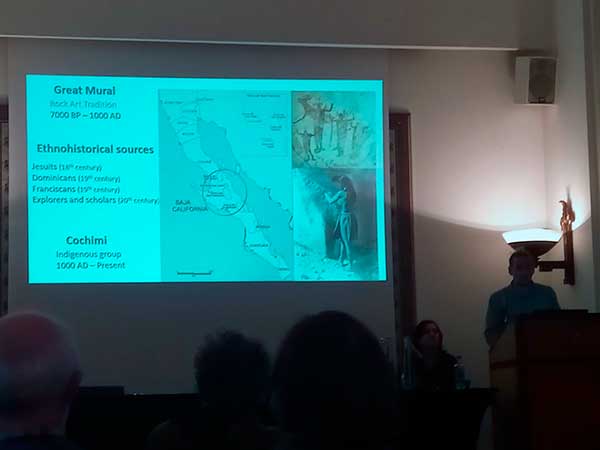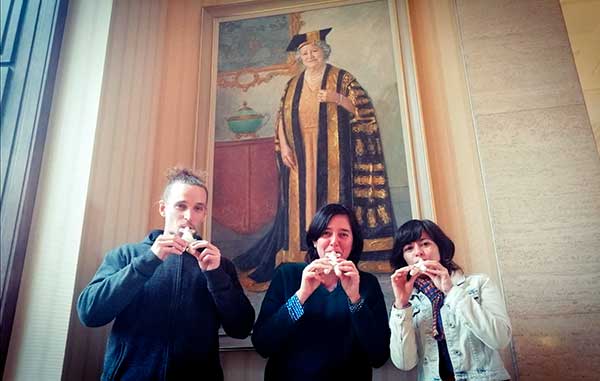By Mathieu Picas, Research Assistant
On the 22 and 23 of November 2019, a special two-day seminar on Music Archaeology in Latin America was held at the Senate House of the University of London. This event was the first meeting ever between the Latin American Music and the Latin American Archaeology seminars of the same university. It was co-organized by the Institute of Latin American Studies of the University of London’s School for Advanced Studies, the Institute of Musical Research (coordinated by the Royal Holloway University of London) and University College London’s Institute of Archaeology. The seminar was the continuation of the 9th Art History Symposium Artes, paisajes y objetos sonoros del pasado celebrated in Bogotá from 25 to 27 September, that had been attended by two members of the ERC Artsoundscapes Project, Principal Investigator Margarita Díaz-Andreu and postdoctoral researcher Ana María Alarcón Jímenez (read Ana María’s blog post about the event here). In this occasion the members of the project to attend were Ana María Alarcon and myself (Mathieu Picas), representing a larger group of Artsoundscapes members. The meeting confirmed the interest among scholars from different regions of the world to create a working group on the archaeology of Latin American music. At a personal level, it was the first time that I had the opportunity to attend such a specialized event on Latin American soundscapes. Within the ERC Artsoundscapes Project I am focusing on the relations between rock art sites, sound and rituality in Baja California, a topic that links with my general interest in the relation between cultural landscapes and cosmology in Mexico and Central America. My participation in the seminar was an enriching experience which allowed me to exchange exciting ideas with other researchers who have been working in these fields for years.
The large number of proposals received by the called was already an indication of the growing interest for pluridisciplinary approaches and methodologies in music archaeology and archaeoacustics. This was demonstrated at the conference, in all the 21 presentations made by participants coming from different disciplines such as archaeology, ethnomusicology, anthropology or architecture. The Artsoundscapes members who attended the event took the opportunity to share the preliminary results of their ongoing work. In ‘Dreaming Music in Water: Representing Yokuts Songs in the early 20th Century’, Ana María Alarcón Jiménez, Raquel Jiménez and Margarita Díaz-Andreu presented the advances of their research on the relations between Yokuts’ sacred landscape and music, paying special attention to the mentions of water and rivers in songs in California (USA). This research, based on an early 20th-century anthropological literature review, was an introduction to the project’s forthcoming fieldwork campaigns in 2020. Leslie Zubieta, María de la Luz Gutiérrez Martínez, Tommaso Mattioli, Mathieu Picas, César Villalobos and Margarita Díaz-Andreu’s ‘Preliminary Results of the Acoustic Analysis of the Great Mural Rock Art in the Cañón de Santa Teresa, Baja California Sur (Mexico)’ presented the results of the archaeoacustic research carried out in Baja California (Mexico) in May 2018 funded by the Fundació Palarq. The presentation received interesting reactions and suggestions. Archaeologist Bill Sillar, for example, asked us whether the project will include experiments with bullroarers when measuring the acoustic properties of shelters.

Mathieu Picas and Leslie Zubieta presenting their paper at the seminar
Among the multitude of scientific methodologies shared in the presentations, Manuel Castillo May’s approach in ‘Postcolonial rhythms and ritual spaces of the Maya’ particularly interested me. His research about prayers and rattle-playing rhythms is innovative in the way that he considers music playing as an act of knowledge transmission related to cosmology, in this case between a jméen (a Maya ritual expert) and other participants. This presentation was based on a ceremony he experienced himself in Campeche (Mexico) and reinforced the argument that music is a social action and has a social use. Indeed, to understand music as a social practice, it is necessary to take into consideration the religious and spiritual aspects and contexts of music playing. In her presentation ‘Sound and Music in Andean Pre-Columbian Art: Interdisciplinarity, methodological aspects and interpretative reach’, Daniela La Chioma evoked the need to have an epistemological approach to study non-western sound and music making. For instance, she mentioned that the Andean precolonial concept of “music” could be the one of “soplar juntos” (blow together), a reference to panpipes orchestra playing. This social dimension of music was also mentioned in other papers, such as the one of Ricardo Alvarez, ‘Bailes Chinos at the Feast of San Pedro: Recreation of Ancient Musical Practices in Contemporary Religious Celebrations in Chile’. The Bailes Chinos are a type of dance that emerged as a strategy of cultural resistance against European colonialism in an identity-making process. Ricardo Alvarez explained that this dance had been recently performed as a symbol of modern resistance during the social protests that Chile is witnessing since October 2019.
Regarding experimental research, there were several fascinating talks . For instance, Katrina Kosyk’s ‘Sonic Gestures, Engaged Performance, and Sound Materialization’ was an interesting presentation of her research on identifying instrument playing gestures through an archaeological study of musical instruments in Mexico. Also, in ‘The Teotihuacan Sound Mapping Project: Exploring the Sonic Sphere of the City of the Gods, Mexico’, Arnd Adje Both explained the methodology he is implementing to reconstruct archaeological musical instruments and ancient soundscapes.
Different common ideas came out of the plenary session. Perhaps one of the most crucial was to design participative research and to involve local communities’ during fieldwork. Some of the scholars who attended the seminar, such as Miriam Kolar, are already closely working with local communities. Another issue discussed was the possibility to have a panel in the next 57th International Congress of Americanists (ICA 2021), in Foz de Igazú (Brazil) in 2021. This will be a good strategy to maintain and reinforce the synergies created by this international working group on Latin American Music Archaeology. A musician attending the seminar suggested that the presentations should include more music since it is our main scientific focus. This statement was well received by all the participants and it seems like his idea was anticipated by the organizing committee which included an Andean musical performance in the programme of the closing reception.
On behalf of the ERC Artsoundscapes Project we would like to sincerely thank the organizing committee, Henry Stobart, Bill Sillar, Dianne Scullin and Manuel Arroyo-Kalin, for the great work that they put in the seminar, for the stimulating debates and the warm welcoming that we received in London.

Playing instrument replicas at the conference. From left to right: Mathieu Picas, Leslie Zubieta and Ana-María Alarcón-Jiménez
